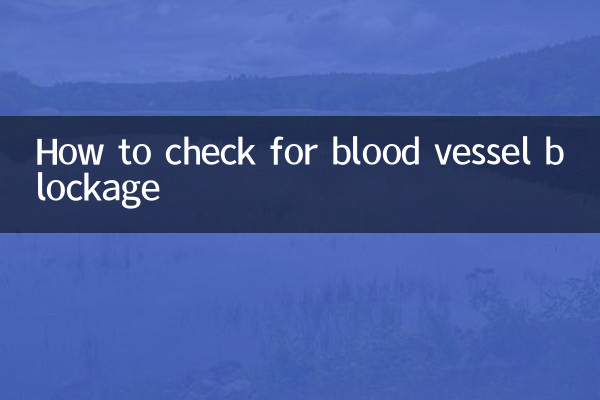How to check for blood vessel blockage
Blood vessel blockage is a common health problem that may lead to cardiovascular and cerebrovascular diseases, such as myocardial infarction, stroke, etc. Early detection of blood vessel blockages is critical to preventing and treating these conditions. This article will introduce in detail the detection methods of blood vessel blockage, and combine the hot topics and hot content in the past 10 days to provide you with comprehensive information.
1. Common examination methods for blood vessel blockage

There are many ways to check for blood vessel blockage. The following are some common inspection methods:
| Check method | Applicable parts | advantage | shortcoming |
|---|---|---|---|
| Electrocardiogram (ECG) | heart | Non-invasive and fast | Can only detect heart problems |
| Ultrasound examination | Carotid arteries, lower limb blood vessels, etc. | Non-invasive and intuitive | Depends on operator skill |
| CT Angiography (CTA) | systemic blood vessels | High resolution, comprehensive | Need to inject contrast agent |
| Magnetic resonance angiography (MRA) | systemic blood vessels | No radiation, high resolution | higher cost |
| coronary angiography | heart coronary arteries | gold standard, accurate | Invasive, requiring hospitalization |
2. Hot topics in the past 10 days and vascular health
Recently, vascular health has become the focus of public attention. The following are related topics that have been hotly discussed on the Internet in the past 10 days:
1."Vascular aging accelerates in young people": Research shows that modern lifestyle has led to an increasingly serious problem of vascular aging in young people. Smoking, high-fat diet and lack of exercise are the main reasons.
2."Application of AI technology in vascular examination": Artificial intelligence technology is changing the diagnosis method of blood vessel blockage. Through big data analysis, AI can detect vascular lesions earlier.
3."New non-invasive vascular examination equipment": A device called the "Vascular Age Tester" is attracting attention, claiming it can assess the health of blood vessels in just a few minutes.
4."Early Signs of Blood Vessel Blockage": Experts remind that chest tightness, dizziness, and numbness of limbs may be early manifestations of blood vessel blockage, and you should seek medical examination in time.
3. How to choose the vascular examination method that suits you?
When choosing a vascular examination method, consider the following factors:
1.Age and risk factors: People over 40 years old or those with high-risk conditions such as high blood pressure and diabetes should have regular check-ups.
2.Symptoms: Select targeted examinations based on specific symptoms. For chest pain, electrocardiogram or coronary angiography may be given priority.
3.economic conditions: Non-invasive examinations are less expensive, but invasive examinations are more accurate.
4.Medical institution conditions: Different hospitals have different equipment, so you can consult your doctor for advice.
4. Lifestyle suggestions to prevent blood vessel blockage
In addition to regular inspections, prevention in daily life is equally important:
| Precautions | Specific methods | Effect |
|---|---|---|
| healthy eating | Low salt, low fat, lots of fruits and vegetables | Lower blood lipids |
| regular exercise | 150 minutes of aerobic exercise per week | Improve blood circulation |
| Quit smoking and limit alcohol | Quit smoking completely and limit alcohol consumption | Reduce blood vessel damage |
| control weight | Control BMI between 18.5-24 | Reduce cardiovascular burden |
| Regular physical examination | Comprehensive inspection once a year | Early detection and early treatment |
5. Latest advances in vascular examination technology
With the development of medical technology, vascular examination methods are constantly updated:
1.Optical coherence tomography (OCT): Provides microstructure information of blood vessel walls with a resolution of 10 microns.
2.Intravascular Ultrasound (IVUS): Send the ultrasound probe into the blood vessel through the catheter to obtain accurate images.
3.Fractional flow reserve (FFR) measurement: To assess the functional significance of coronary artery stenosis.
4.Wearable vascular monitoring device: Real-time monitoring of blood vessel status, suitable for long-term observation.
Conclusion
Early detection and treatment of blood vessel blockage are crucial to preventing serious cardiovascular and cerebrovascular diseases. By understanding the characteristics of various examination methods, choosing appropriate examination methods based on your own situation, and taking active lifestyle interventions, you can effectively maintain vascular health. The recent hot topic about vascular health also reminds us that the health challenges brought by modern life need to be paid enough attention.
If you have concerns about blood vessel blockage, it is recommended to seek medical advice promptly and consult a professional doctor to develop a personalized examination and prevention and treatment plan. Remember, prevention is better than cure, and a healthy lifestyle is the best “blood vessel cleaner”.

check the details

check the details